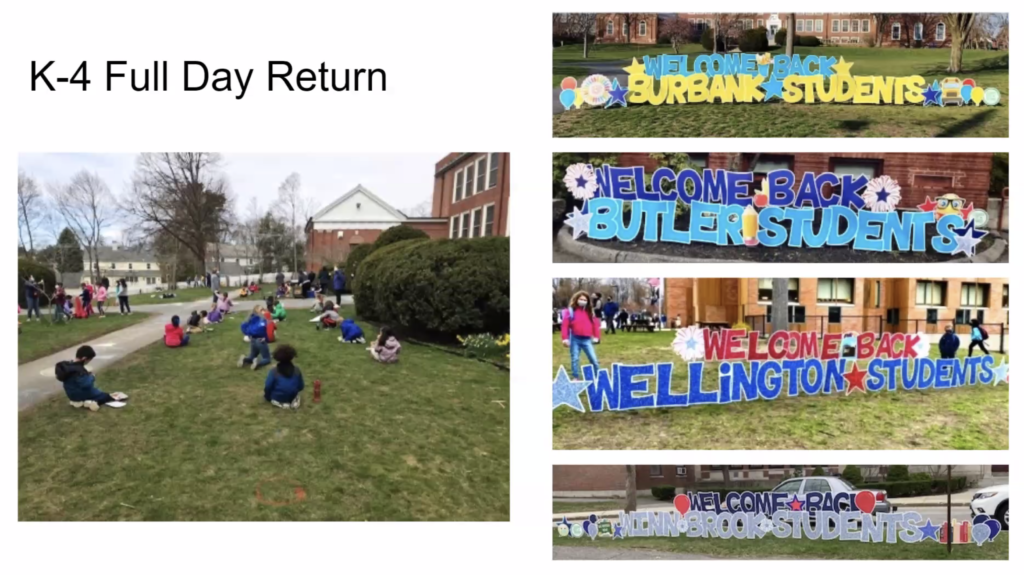Photo: Belmont students will start the new school year wearing masks.
Belmont students and teachers throughout the district will be wearing masks to start the new school year beginning on Thursday, Sept. 9, after the Belmont School Committee at its Monday, Aug. 9 meeting accepted a town-wide universal mask mandate approved by the Board of Health and the Belmont Select Board on Friday, Aug. 6.
The committee will “revisit the mask policy and discuss strategies to increase vaccination rates” with the Health Board sometime at the end of September, according to the policy.
“I believe it’s really important to provide Belmont school families and staff with clarity about the masking plans and requirements for the beginning of the 2021-22 school year,” said School Board Chair Amy Checkoway.
Attended by approximately 200 via Zoom, the meet showed no sign of contentiousness or rancor seen at school committee meetings across the country – notably one held on Tuesday in Franklin, Tenn. – that resulted in anti-masking protests and threats of violence, while a Fox Entertainment personality claimed masking students is done to “terrify” them and anti-mandate decrees being issued by a handful of governors.
During the three hour meeting, Superintendent John Phelan presented the district’s proposed “Back to School Health/Safety Protocol Plan” for the 2021-22 school year created by the district’s Health Team. Its recommendations include:
- Implement indoor masking for staff and students in accordance to the Aug. 6 town-wide decree.
- Masks required on buses and at health clinics.
- No mandate for outdoor activities or while students are at lunch.
- Maximize distances in classrooms and cafeterias at the elementary and middle schools including providing outdoor space.
- Encourage vaccinations for staff and students 12+ and host vaccination sites at schools.
- Testing, quarantining and contract tracing is also recommended; the district is waiting for state guidance.
Phelan told the committee the district would be seeking direction on creating an indoor mask mandate for the entire student population and staff. The Health Team’s guidance would be provided by the state – using the Department of Public Health (DPH) and the Department of Elementary and Secondary Education (DESE) – the federal government’s Centers for Disease Control and Prevention and the American Academy of Pediatrics.
Phelan noted “there’s a lot of similar guidance” from the three sources and that included masking for all preschool and elementary school students as they currently can not be vaccinated. The one area Phelan said where the three entities differed is in-school masking for vaccinated student in 7th through 12th grade. While the AAP and CDC recommend masks, the state’s DPH advise masks if the student lives with someone who is not vaccinated or immunocompromised while DESE would allow vaccinated students to remain maskless while indoors.
Masking challenge for High School students
Since half of the grades at the Belmont’s Chenery Middle School fall under the elementary policy and the other half in the 7th to 12 range, Phelan said it was best that all students remained masked as the four grades will come in contact throughout the day. This left the School Committee to determine the masking in the traditional 9-12 high school grades.
Adrienne Allen, the Board of Health’s observer at the School Committee, told the committee that as a physician she was “very hopeful” two months ago that vaccinations would create a situation where mask use could safety be reduced. “But then things rapidly changed before our eyes with [the] Delta [variant],” she said, with the most disconcerting part being vaccinated people can spread the variant which is nearly as contagious as chickenpox.
With the overriding goal of the School Committee and district is to “keep kids in school as much as possible” while mitigating harm as much as possible, said Allen. And masking protects people from a source; for example, “if I had Covid and I’m wearing a mask, you’re protected. But it also protects other people.”
So if you want to keep students in school and protected, the schools should have a universal mask mandate, said Allen.
It soon became clear the Committee’s consensus was to start the school year with grades Pre-K to 12 masked. And each of the members agreed there will likely be a time when the mandate will be modified or ended. Coming to what that point was where the committee split.
For Jamal Saeh, the answer, for at least 7th to 12th grade pupils, was already baked into the town-wide mask mandate. Rather than reinvent the wheel, Saeh pointed to the town policy that says the mandate will end when the level of community transmission for Middlesex county as recorded by the CDC is designated as either low or moderate for two consecutive weeks.
But the other members pointed to the unique nature of the schools where, unlike the town-wide impact on stores, eateries and offices in which people may spend a few minutes to an hour, students and staff in schools are inside and interacting with dozens of fellow students for six hours or more.
Committee member Mike Crowley what masking does is helps the district “avoid disruptions that so rattled the community last year.” And while it’s impossible to know with any certainty what the coming year will bring but masking seems to be a fairly effective strategy.” For Crowley and others, rather than have a “ridged” standard as the town-mandate, the policy should be reviewed on a regular basis.
The committee did agree with Saeh that the first review of the mask mandate should take place in late September and also to advocate for increased vaccinations among students – those in 9th to 12th grades have about a 80 percent fully vaccination rate – with future discussion on a possible requirement that staff be vaccinated.
”If we learned one thing from last year, it’s that people value in person schooling,” said Committee member Andrea Prestwich, and masking not only tamps down Covid spread but also the flu and other respiratory illnesses “and takes some of the load off of our nursing staff.”


